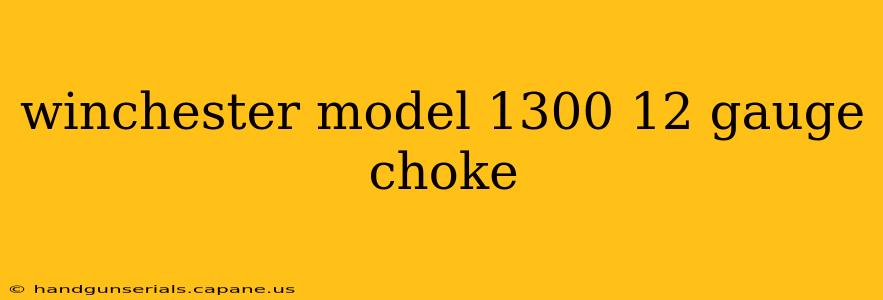Understanding Your Winchester Model 1300 12 Gauge Choke
The Winchester Model 1300 is a popular and versatile shotgun, known for its reliability and performance. A key component contributing to its effectiveness is the choke tube. Understanding your choke and how it impacts your shooting is crucial for maximizing your accuracy and enjoyment. This article will delve into the intricacies of the Winchester Model 1300 12 gauge choke system.
What is a Choke Tube?
Before we dive into the specifics of the Winchester Model 1300, let's establish a foundational understanding of choke tubes. A choke tube is a constricted device located at the muzzle of a shotgun barrel. It controls the pattern of shot pellets as they leave the barrel. This constriction affects the shot's spread, influencing range and density. Different chokes offer varying degrees of constriction, impacting your shooting effectiveness depending on the target and hunting situation.
Winchester Model 1300 Choke Types and Their Uses
The Winchester Model 1300 typically accepts standard Invector-Plus choke tubes. This means you have a wide array of options available to fine-tune your shotgun for various applications. Here are some common choke types and their ideal uses:
-
Cylinder: This choke offers the widest shot pattern, ideal for close-range shooting like flushing birds at very close ranges. Expect a very open pattern, but with reduced accuracy at longer distances.
-
Improved Cylinder (IC): A slightly tighter constriction than Cylinder, offering a balance between range and pattern density. Suitable for close to medium-range shooting of various game.
-
Modified (Mod): Provides a tighter pattern than IC, extending effective range while maintaining a decent shot density. A versatile choice for many hunting scenarios.
-
Improved Modified (IM): Falls between Modified and Full, providing a good compromise between pattern density and range. Excellent for waterfowl or upland birds at moderate distances.
-
Full: The tightest choke, offering the most concentrated shot pattern and the longest effective range. Best suited for long-range shots at waterfowl or other distant targets.
Choosing the Right Choke for Your Winchester Model 1300
Selecting the appropriate choke depends heavily on your target and the distance at which you'll be shooting. Consider these factors:
-
Target Type: Waterfowl hunting generally requires tighter chokes like Modified or Full for longer-range shots. Upland bird hunting often benefits from Modified or Improved Cylinder chokes. Close-range shooting might be better served with Cylinder or Improved Cylinder.
-
Distance: Longer distances necessitate tighter chokes to maintain sufficient shot density for a clean kill. Shorter distances allow for the use of more open chokes.
-
Shot Size: The size of your shot also influences choke selection. Smaller shot sizes generally benefit from tighter chokes to maintain pattern density.
Maintaining Your Winchester Model 1300 Choke Tubes
Proper maintenance is crucial for the longevity and performance of your choke tubes. After each shooting session, clean your choke tubes thoroughly with a brush and solvent to remove any residue. Store your choke tubes in a protective case to prevent damage or loss. Regular cleaning will ensure consistent performance and prevent any issues that could impact your shooting accuracy.
Conclusion
Understanding your Winchester Model 1300 12 gauge choke is paramount for achieving consistent accuracy and successful hunts. By carefully selecting the right choke for the specific hunting situation and maintaining your equipment properly, you'll significantly enhance your shooting experience. Remember to always practice safe gun handling and follow all relevant safety regulations.

